Solids Chapter Notes | Mathematics Class 9 ICSE PDF Download
| Table of contents |

|
| Introduction |

|
| Cuboid |

|
| Cube |

|
| Cost of an Article |

|
| Cross-Section |

|
| Flow of Water (Or Any Other Liquid) |

|
| Solved Examples |

|
Introduction
Imagine building a model castle or designing a storage box—how much space does it take up, and how much material do you need to cover it? Welcome to the fascinating world of 3-D solids! In this chapter, we dive into the concepts of volume and surface area for shapes like cuboids and cubes. We'll explore how to calculate the space they occupy and the area of their surfaces, which is super useful in real-life scenarios like construction, packaging, or even planning a water tank. Get ready to unravel the math behind three-dimensional objects in a simple and engaging way!
Solid: A solid is any object that takes up space and has a definite shape.
Volume refers to the amount of space a solid occupies.
- The capacity of a container is its internal volume.
- For hollow objects, the volume of material is found by subtracting the internal volume from the external volume.
Surface area is the total area of all the surfaces of a solid.
- Solids are three-dimensional (3-D) because they have length, breadth, and height.
- In contrast, an area (like a rectangle) is two-dimensional (2-D) with only length and breadth.
- A perimeter is one-dimensional (1-D) as it only involves length.
Cuboid
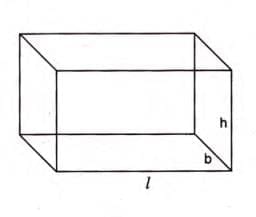
- A cuboid is a rectangular solid with six faces, each being a rectangle.
- Formulas for a cuboid(length = l, breadth = b, height = h):
- Volume = l × b × h
- Total surface area = 2(l × b + b × h + h × l)
- Lateral surface area = 2(l + b) × h
- Length of diagonal = √(l2 + b2 + h2)
- The diagonal of a cuboid is the longest rod that can fit inside it.
- Every cuboid has four equal diagonals (e.g., AG, BH, CE, DF in a cuboid).
Example:
A closed wooden box has outer dimensions of 22 cm, 15 cm, and 10 cm, with a wood thickness of 1 cm. The volume of wood is calculated as the difference between external and internal volumes.
- External volume = 22 × 15 × 10 = 3300 cm3.
- Internal dimensions = (22 - 2 × 1), (15 - 2 × 1), (10 - 2 × 1) = 20 cm, 13 cm, 8 cm.
- Internal volume = 20 × 13 × 8 = 2080 cm3.
- Volume of wood = 3300 - 2080 = 1220 cm3.
Example:
A small indoor greenhouse (a cuboid) has dimensions 40 cm × 30 cm × 25 cm, made entirely of glass panes.
- Area of glass (total surface area) = 2(40 × 30 + 30 × 25 + 25 × 40) = 2(1200 + 750 + 1000) = 5900 cm2.
- Tape length = Perimeter of top + Perimeter of bottom + Four vertical edges = 4(40 + 30) + 4 × 25 = 380 cm.
Cube
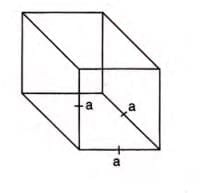
- A cube is a special cuboid where all six faces are squares of equal size.
- If the edge of a cube is 'a', then length = breadth = height = a.
- Formulas for a cube:
- Volume = a × a × a = a3
- Total surface area = 6a2
- Lateral surface area = 4a2
- Length of diagonal = √(a2 + a2 + a2) = a√3
Example:
A cube of metal with a 5 cm edge is melted and recast into a cuboid with a base of 2.5 cm × 0.5 cm.
- Volume of cube = 5 × 5 × 5 = 125 cm3.
- Volume of cuboid = 2.5 × 0.5 × h = 125.
- Height (h) = 125 / (2.5 × 0.5) = 100 cm.
- Surface area of cube = 6 × 52 = 150 cm2.
- Surface area of cuboid = 2(2.5 × 0.5 + 0.5 × 100 + 100 × 2.5) = 602.5 cm2.
Cost of an Article
- The cost of an article is calculated by multiplying its quantity by its rate.
- Formula: Cost = Rate × Quantity
- Examples of cost calculation:
- Petrol is bought by volume: Cost = Volume of petrol × Rate per unit volume.
- Land is bought by area: Cost = Area of land × Rate per unit area.
- Cloth is bought by length: Cost = Length of cloth × Rate per unit length.
Example:
A solid cubical block of wood costs ₹250 per m3, and a block is bought for ₹182.25.
- Volume = Cost / Rate = 182.25 / 250 = 0.729 m3.
- Edge of cube = (0.729)1/3 = (729/1000)1/3 = 0.9 m (using factors: 729 = 33 × 33, 1000 = 103).
Cross-Section
A cross-section is a cut made through a solid perpendicular to its length or height.
A solid has a uniform cross-sectionif the shape and size of the cross-section are the same at every point along its length or height.
- Example: A cuboid or right-circular cylinder has a uniform cross-section.
- A right-circular cone does not have a uniform cross-section because the size of the cross-section changes.
Formulas for solids with uniform cross-section:
- Volume = Area of cross-section × Length
- Surface area (excluding cross-section) = Perimeter of cross-section × Length
Example:
A solid with a trapezium cross-section has parallel sides 23 cm and 17 cm, height 10 cm, and length 1 m.
- Area of cross-section = (1/2) × (23 + 17) × 10 = 200 cm2.
- Volume = 200 × 100 = 20,000 cm3 (length = 1 m = 100 cm).
Flow of Water (Or Any Other Liquid)
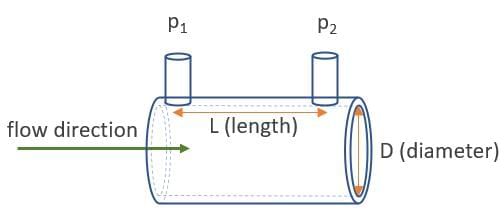
Water Flow Rate
- For a pipe or canal with a uniform cross-section, the volume of liquid flowing per unit time is calculated.
- Formula: Volume per unit time = Area of cross-section × Speed of flow
Example:
A pipe with a cross-sectional area of 5 cm2 has water flowing at 30 cm/s. Find the volume of water flowing in 1 minute.
- Volume per second = 5 × 30 = 150 cm3.
- Volume per minute = 150 × 60 = 9000 cm3 = 9 liters (since 1 liter = 1000 cm3).
Solved Examples
Example 1: Volume and Cost of Wood in a Box
A closed wooden box has outer dimensions 22 cm × 15 cm × 10 cm, with wood thickness 1 cm. Find the cost of wood at ₹7.50 per cm3.
- External volume = 22 × 15 × 10 = 3300 cm3.
- Internal dimensions = (22 - 2 × 1), (15 - 2 × 1), (10 - 2 × 1) = 20 cm, 13 cm, 8 cm.
- Internal volume = 20 × 13 × 8 = 2080 cm3.
- Volume of wood = 3300 - 2080 = 1220 cm3.
- Cost = 1220 × 7.50 = ₹9150.
Example 2: Cuboid from Melted Cube
A cube with a 5 cm edge is melted and recast into a cuboid with base 2.5 cm × 0.5 cm. Find the height and surface areas.
- Volume of cube = 53 = 125 cm3.
- Volume of cuboid = 2.5 × 0.5 × h = 125.
- Height (h) = 125 / (2.5 × 0.5) = 100 cm.
- Surface area of cube = 6 × 52 = 150 cm2.
- Surface area of cuboid = 2(2.5 × 0.5 + 0.5 × 100 + 100 × 2.5) = 602.5 cm2.
Example 3: Rise in Field Level
A field is 15 m × 12 m. A well of 8 m × 2.5 m × 2 m is dug, and the soil is spread over the remaining field. Find the rise in level.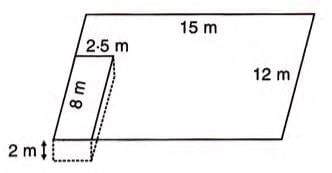
- Volume of soil = 8 × 2.5 × 2 = 40 m3.
- Area of remaining field = (15 × 12 - 8 × 2.5) = 160 m2.
- Rise in level (h) = Volume / Area = 40 / 160 = 0.25 m = 25 cm.
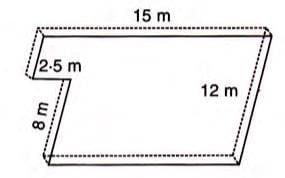
Example 4: Surface Area Using Diagonal
A cuboid has l + b + h = 19 cm and diagonal = 11 cm. Find its surface area.
- Given: l + b + h = 19, and √(l2 + b2 + h2) = 11, so l2 + b2 + h2 = 121.
- (l + b + h)2 = l2 + b2 + h2 + 2(lb + bh + hl).
- 192 = 121 + 2(lb + bh + hl) → 361 = 121 + 2(lb + bh + hl).
- 2(lb + bh + hl) = 361 - 121 = 240 cm2.
- Surface area = 240 cm2.
|
28 videos|171 docs|28 tests
|
FAQs on Solids Chapter Notes - Mathematics Class 9 ICSE
| 1. What is a cuboid and how is it different from a cube? |  |
| 2. How do you calculate the volume of a cube and a cuboid? |  |
| 3. What is the significance of the cross-section in solids? |  |
| 4. How does the flow of water in a cuboidal tank differ from that in a cylindrical tank? |  |
| 5. How can the cost of an article be determined using its dimensions? |  |



















